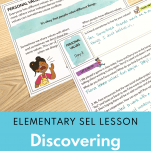Teaching our children about their personal values is a valuable and important lesson. Learning about these core beliefs and principles can equip students with the knowledge to make wise choices for themselves. By exploring their values, kids gain greater insight into themselves, why they do what they do and how their decisions may affect themselves and those around them.
Let's go through a lesson you could do on personal values with a whole class, small group, or individual student.
Step By Step Personal Values Lesson
Define Personal Values
First, start by defining what personal values are. How have students already seen these displayed by themselves and others?
Personal values are the core beliefs and principles that shape our daily lives. They encompass how we think, how we act, and what we ultimately care about. Personal values help us determine what is essential and decide based on those priorities. Personal values include kindness, honesty, respect, integrity, and fairness.
You could ask students to define what they think personal values are in their own words.
Discuss Influences on Our Personal Values
Various factors, such as our personalities, friends and family members, cultural beliefs, and experiences, shape our values. Our perspectives on life can be molded by the people we surround ourselves with, the books we read or movies we watch, and even the conversations that occur in our daily lives.
Culture also impacts how personal values develop; different cultures have different ideas about what is important to prioritize in life. Religious beliefs or political ideologies can also determine individual values. Ultimately, it’s up to each person to decide which influencing factors will shape their value system.
Have students draw themselves at the center of a paper or write their names. They can write down the different people, places, and circumstances influencing them.
Brainstorm Possible Values
When teaching students about personal values, provide a space for them to brainstorm and discuss what they know. For example, as a group, teachers can have their third-grade students explore current events or characters in books as sources of inspiration for understanding different values.
This can be done by looking at characters' actions in stories and asking questions such as “What value does this character demonstrate?” Or, when discussing current events, teachers can ask their class, “What value do you think is most important here?”
Work with students to generate a list of values they have observed in others and themselves.
Use Personal Values Scenarios to Explore
Once you have identified various personal values, give them scenarios to predict their decision if they have a particular value. For example, if the class discusses honesty, you can provide a hypothetical situation such as, "You find a wallet with money in it."
Another option would be to give them a scenario and the decision someone made. They then have to decide what value guided that decision.
Circle - Star - Slash Personal Values Activity
Use the list of personal values that you brainstormed as a group. Give each student a copy of the list. Tell them to review the list and circle the values that are important to them. You can limit this to 7-10 values. Next, tell them to slash the values that aren't important to them. Lastly, they should look at the circled values and put a star next to the three values that are most important to them.
After identifying their three values, discuss how they influence their thoughts, feelings, actions, and decisions. Then, you can use the previous scenarios to discuss how their values impact decisions.
Personal Values Worksheets
Students will learn what values they find important and how their values affect how they act, think, and feel.

Personal values are an essential part of understanding and informing our decisions. Teaching children about personal values can help them become more self-aware and confident decision-makers. Through activities such as brainstorming possible values, exploring scenarios to demonstrate how those values influence us, and the Circle-Star-Slash activity to identify their most important three values, you can give students with a better sense of who they are and what matters most to them.
In This Post

Personal Values Lesson
Five no prep 15-minute SEL lessons you can use to teach students about their personal values - what is important to them. These print-and-go worksheets will help students learn what they value and how that affects how they feel and act.



